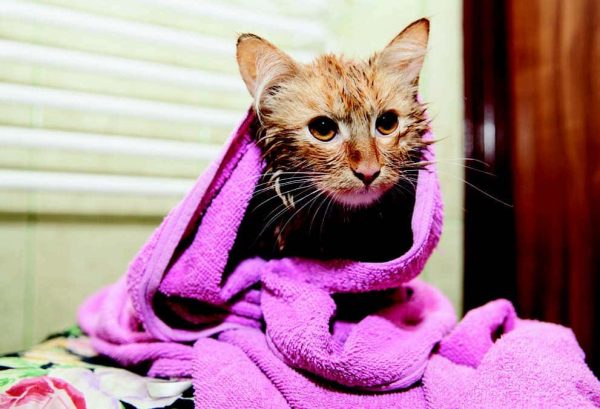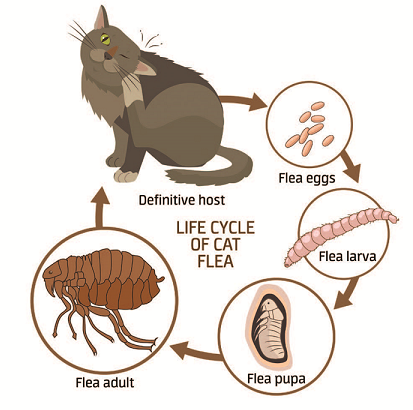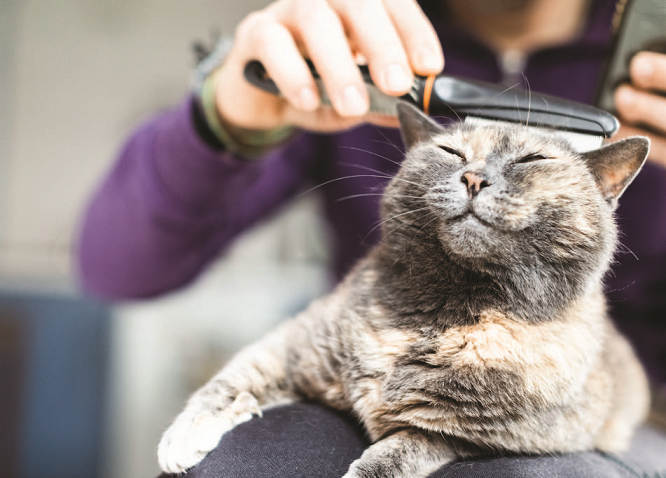Just adopted a kitten? Or share your home with adult cats? Or, do you care for a community cat colony in your neighborhood? No matter the environment, the challenge remains: keeping fleas off felines. These blood-sucking nuisances possess a strong ability to survive, considering that they have been pestering mammals and birds for more than 50 million years. And, they are quite prolific, as each female flea can lay up to 50 eggs a day.
“The good news is in the war against fleas and ticks, we are in good stead,” says Dr. Michael Dryden, distinguished professor of veterinary parasitology at Kansas State University. “The new generation of flea and tick products are remarkable at the speed of killing fleas not only when first given, but throughout the duration of the label. The key is following the label instructions and using consistently.” Untreated, a cat coping with flea attacks can suffer anemia, develop flea allergy dermatitis, develop cat scratch disease (Bartonella henselae) and itch, itch, itch like crazy.
So, what’s the best game plan to keep your feline friend flea-free? Let’s divide cats into four categories – kittens, indoor cats, community cats, and those with medical issues or who are well into their senior years. Scratch up the right stuff to navigate fleas with ease.

©FARBAI | Getty Images ©dreamboxstudio | Getty Images
There is a reason the kitten I adopted from Samantha Martin of The Amazing Acro-Cats came with the name of Rusty. She found him when he was a young, orphaned kitten covered with fleas. Some were running in his ears and even his nostrils.
“When I gave him a bath, the bath water turned a rust color, indicating blood from all the flea bites on him,” Samantha says. “It took three baths before the water was clear. The next step was to use Dawn soap on him, leave it on a few minutes and then rinse and use the flea comb to get the remaining fleas off him.”
Samantha, a renowned animal trainer who operates Meowy Manor just outside of Atlanta, Georgia, says young kittens like Rusty are at high risk for becoming anemic, causing a decrease in needed red blood cells and a weakened immune system.
“The very young kittens cannot handle commercial flea medications because their immune systems and flea combing,” she says. “Once kittens are about 2 pounds, you can work with your veterinarian about using products like Capstar that quickly kills fleas in about 30 minutes.”
Rusty’s name stuck, but I am happy to report he is flea-free as he nears age 2 due to being given regular flea preventive medications.
Oust Fleas in Colonies
Preventing a flea raid in community cat colonies all over the country is a benefit to both these cats and local residents.

People like Stacy LeBaron, host of the Community Cats Podcast and organizer of many national and international conferences on community cats, educates people on how to safely approach and treat these cats.
“If you can handle the cat, you can use topicals,” she says. “Certainly, those community cats who are humanely trapped to be spayed and neutered and given needed vaccines at the veterinary clinic, are also given flea treatments at that time.”
She adds, “If you have a food-focused cat, you can feed him treats as a distraction as you apply the topical behind his shoulder blades. What we don’t recommend is trying to wrap a community cat in a towel as you will face a battle that you probably will lose.”
Another option: Try sprinkling diatomaceous earth around where the community cats hang out.
“Diatomaceous earth is safe for use on cats, and it kills fleas in all life stages by dehydrating them,” says Dr. Jean Hofve, a holistic veterinarian from Denver, Colorado.
Cater to Couch Potatoes
Inside my home, four well-groomed, flea-free cats rule the sofa. I view providing Casey, Mikey, Mort and now Rusty with monthly flea treatments as a smart investment. They are less apt to develop flea-related health issues, and my home interior remains parasite-free.
That means that this feline foursome is given flea preventives even during the cold winter months.
“Gone are the days of skipping a month to save money,” says Dr. Dryden. “It doesn’t matter if you live in Tacoma or Tampa. Parasite protection needs to be year-round for your cat.”
He adds that it is vital to apply the topical correctly.
“In order for it to work properly, topicals must reach the pet’s skin,” says Dr. Dryden. “If you just apply it on the topcoat, it loses its effectiveness to kill fleas.”
I also treat my cats to regular brushing sessions, using that time to examine their coats and skin for any signs of fleas, matted fur, cuts or lumps.
Aiding Sensitive Types
Roughly about 5% of cats show some allergic reaction to flea topicals, according to leading veterinary parasitologists. Symptoms range from a red, itchy rash at the site of application to blisters and crusting throughout the skin.
For such allergy-prone cats or elderly cats with compromised immune systems, consult your veterinarian about the best prescription-based flea repellent medication, ideally, one with a fast-acting adulticide to kill adult fleas.
However, veterinarians do not recommend fitting sensitive cats with flea collars, as they may be at risk for developing contact dermatitis.
The bottom line: You possess more options now than ever before to fend off fleas.
“Many medications today that deal with fleas work well, but the best one is the one that the cat owner uses consistently,” Dr. Dryden says.
Certified pet behavior consultant, author and master pet first-aid instructor Arden Moore often teaches hands-on classes with her cool cat, Casey and very tolerant dog, Kona. Each week, she hosts the Oh Behave Show on Pet Life Radio. Learn more at ardenmoore.com and petfirstaid4u.com.
